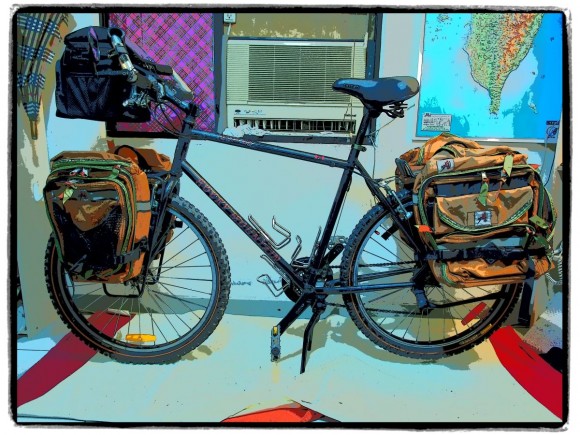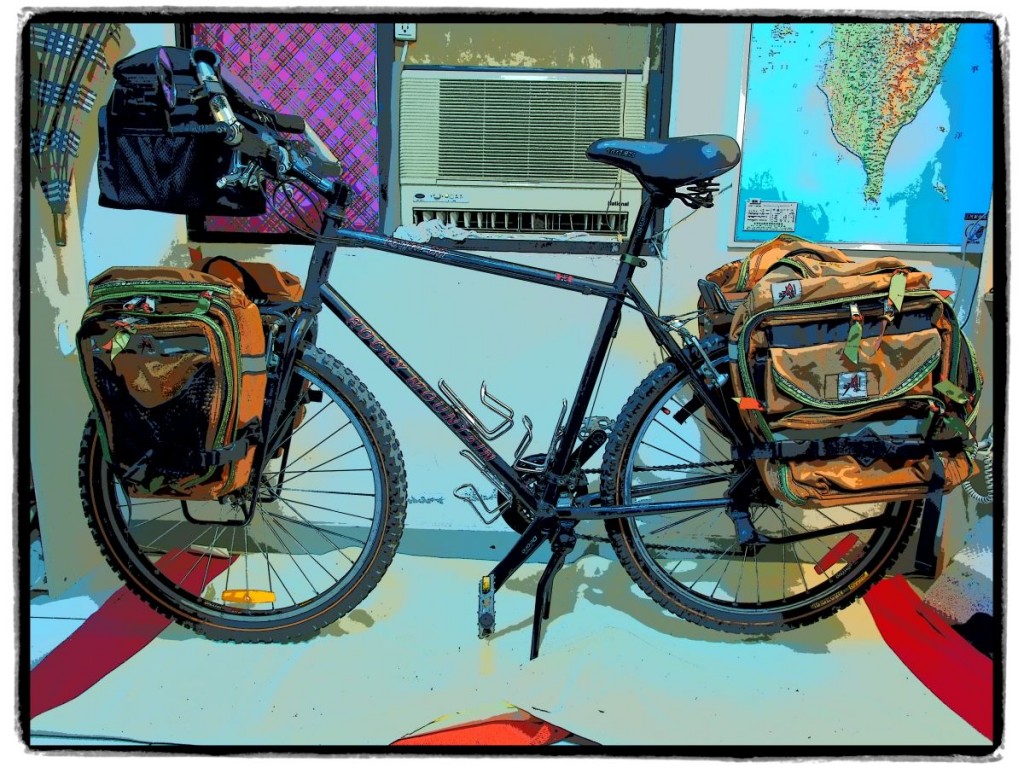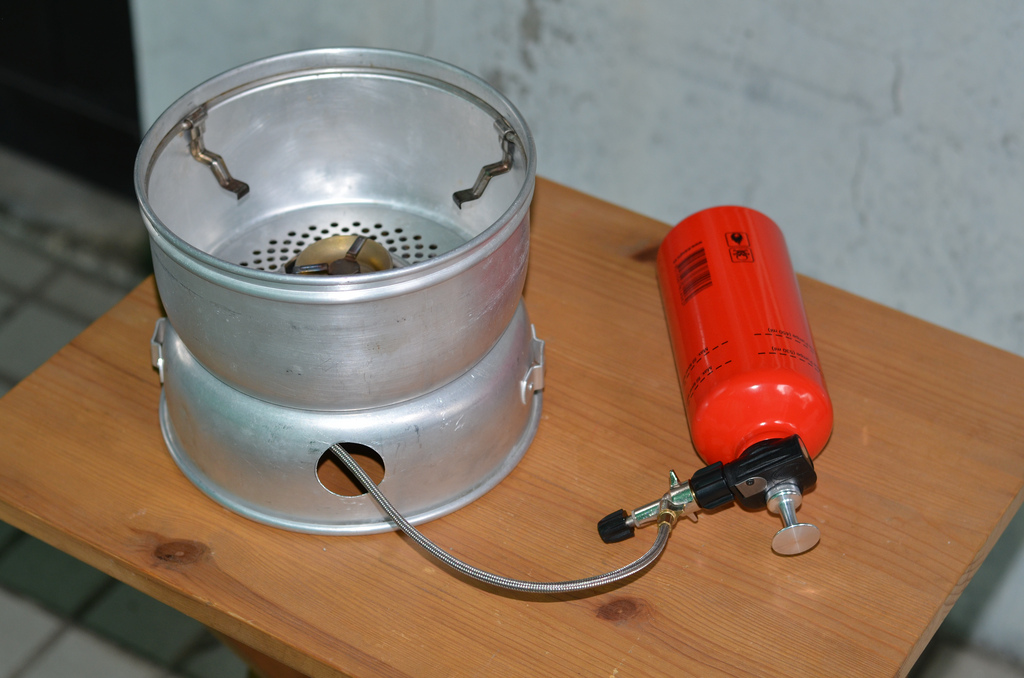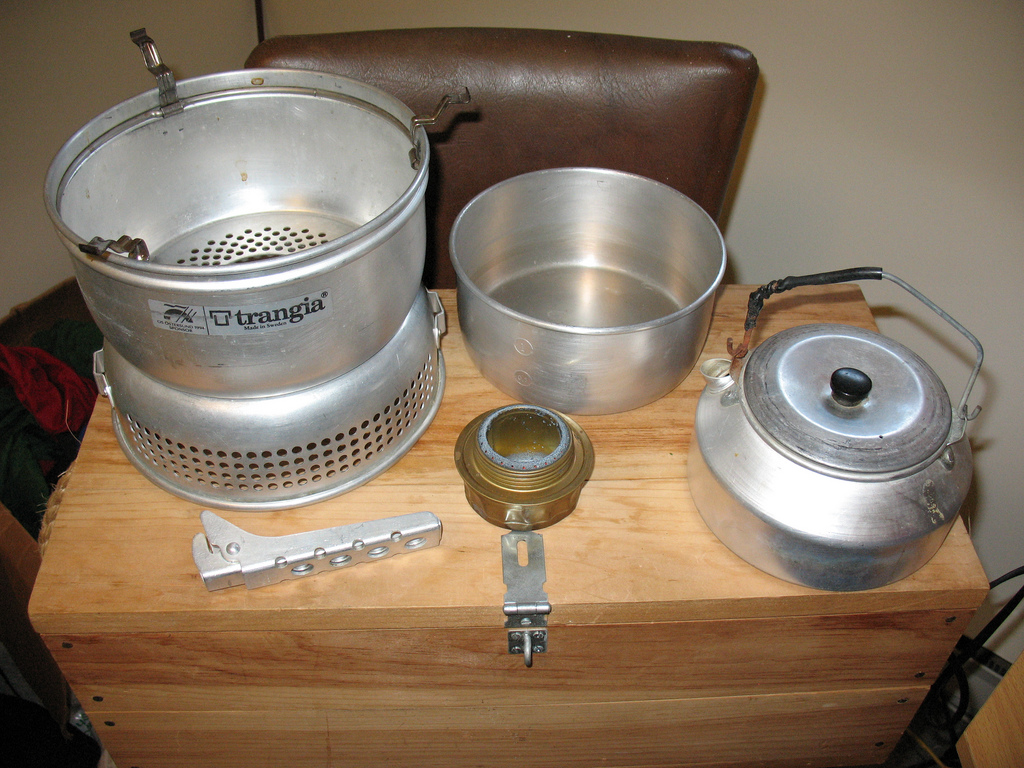Cleaning Up My Bike and My Trangia Cookstove Set
Thursday December 27, 2012
8:30 a.m. at the 7-11 on Chang-An Road
My plan for last Sunday was to work on my bike, and I did just that. I first had to make room for the beast, and I moved furniture around until I had created a spot in the living room. That involved moving my sofa to the other side of my small living room and moving a desk, which serves as my kitchen table. The desk has now become my work station for all my bike tools. And the shelves on that desk have become where I put all the stuff that is going with me on the bike – my tent and sleeping bag, etc.
I put an old rug and some old blankets down on the floor and then rolled my bike on top of that. I vacuumed as much dust off the bike as I could and then I wiped it down with wet and dry rags. I went about it pretty thoroughly and removed a bunch of bike parts so that I could clean them as well and get into all the nooks and crannies. The bike went from a soft grey to its natural shiny black. I also like to remove components from the bike from time to time just to keep all the screws and bolts clean and lubricated. That makes it easier to maintain the bike. I remove the pedals quite frequently just so that when the time comes to remove them for transport, it is easy to do. Pedals, since they are turning all the time, tighten themselves naturally. They are also exposed to the elements all the time and take the full force of the effort of your legs as you pedal. Therefore, when you are trying to get your bike ready for a flight and trying to take the pedals off mid-journey, it can be impossible. Bike shops actually have special tools for this – heavy-duty pedal wrenches with thin jaws. These wrenches can be very long and give you a lot of leverage. Removing pedals without a dedicated pedal wrench can be a disaster. It’s common for cyclists to just about lose their minds trying to remove pedals on their own. I remember facing this problem before I left for Ethiopia. Despite all my planning, I had somehow left packing up the bicycle to slightly too late, and there I was in the middle of the night screaming and yelling as I tried to wrestle off those pedals. You often end up applying so much pressure to whatever wrench you’re using that when the wrench slips – as it inevitably does – you can bang up your knuckles quite badly and even cut yourself badly. It’s a bad scene. So it’s a good idea to just remove the pedals from time to time and clean the threads and grease them before putting them back on. Another quirk is that one of the pedals has a reverse thread, and if you are feeling tired, it can be next to impossible to figure out which way to turn the bolt to loosen the pedal. If you guess wrong, you end up throwing your entire strength into it and all you’re doing is tightening it even more. It can be a real disaster.
Once the bike was cleaned up, I went over all my pannier bags and cleaned and lubricated the zippers. I own, in fact, the best pannier bags in the world – in my humble opinion anyway. People have different preferences for this sort of thing, but I prefer a bag with lots of pockets and compartments, and none are better for that than Arkel bags. I also prefer bags that have a nicely defined shape rather than just soft lumpy bags that bulge in all directions. And finally, I prefer a bag that is durable. And the Arkel bags fit all these requirements. On the downside, they are a bit heavy. The zippers, for example, are industrial strength and giant sized – designed to last for several lifetimes. I haven’t used my bags for a while and a bit of oiling of the zippers was required. Then I mounted the bags on the bike and started filling them up with stuff.
I have a long and complicated relationship with stuff. It would be nice, of course, to travel with less stuff – to travel light. However, that means being less independent. The less stuff you have, the more you have to find along your way. You can, for example, travel with no sleeping bag and no tent. But then you always have to find a place to stay for the night. You could also travel with a thin and small sleeping bag. But then you might have to ask for extra blankets at hotels. And so on.
So I tend to have a lot of stuff. On top of that, I gravitate towards stuff that functions well. I don’t just pick up whatever is lightest and smallest. I buy whatever serves best. And that often means it is a bit heavier and larger than other options. Then I go through a long process of agonizing over it. When I’m packing – as I’m doing now – I wish my stuff was lighter. When I go to the airport, I wish my stuff was lighter. On the positive side, I don’t really find the weight a problem when I’m actually cycling. I don’t cycle fast, so the weight isn’t a big deal. And once you get used to it, all the stuff jammed onto the bike isn’t a big deal.
Anyway, I started on Sunday with my pots and pans and stove. I currently have a Trangia set. It’s a specialized stove out of Sweden and the pots and the windshield and the burner are all essentially one unit. Most other stoves are separate units. They’re burners with a fuel tank attached and then you can put whatever pots on top of it that you want. With the Trangia, the burner fits inside the two-part wind screen and the pots nest inside the wind screen. Plus, there are two burners. I have the original Trangia burner, which burns alcohol. It’s essentially a sophisticated fondue cooker. And recently, I purchased the new Trangia multi-fuel burner. This is a more traditional burner and comes with a fuel tank, which you must fill with fuel and then pressurize with the attached pump. It works best with regular camping fuel – white gas. However, it can burn pretty much anything you put into it – diesel fuel, gasoline, kerosene, aviation fuel, etc.
The Trangia system comes in a multitude of sizes and weights. Essentially, though, there are two sizes. There is a small size for one or two people. And then there is a large size meant for groups of three to four. Of course, I have the large size. In this case, it makes sense. I bought this Trangia something like 25 years ago, and at that time I decided that the small size was simply too small even for one person. And I believe I was right. I used that stove intensively on a bike ride across Canada and on another ride north to south through the United States, and I found that when I made a spaghetti dinner, for example, I needed the large pot. A smaller pot would not have been large enough for me. And it turns out that the new Trangia multi-fuel burner can’t be used in the small set anyway. It produces so much heat that, according to the company anyway, it would melt the pots and/or wind screen.
I thought about buying a new Trangia set for this trip. I still might do it. They now make ultra-light versions made out of space age material. But my old set still works fine more or less. I say more or less because it suffered some damage when my brother shipped it to me from Canada. For some reason, he took the kettle lid and flipped it upside down and put it inside the pots with weight on top of them. So on the entire journey here, the lid banged and smashed into the bottom of the pot and warped it and dented it. It would still work, but it was so badly banged up that I think the cooking heat would not be evenly distributed and it would burn in certain points. Luckily, I also have a set of stainless steel MSR pots, and the small MSR pot is the same size as the large Trangia pot that got all banged up. So I switched them around. I now have one Trangia pot and one MSR pot plus the Trangia kettle. Once I put it all together, it feels pretty heavy. But, as I said, that’s okay. I could save weight by not bringing the kettle, for example. Who needs two pots and one kettle? I found, however, on previous trips that I loved having the kettle. I could boil water in one of the pots for tea and coffee, but it isn’t nearly as efficient or pleasant. It was great while camping to be able to heat up water in the kettle and have it nice and hot while cooking in the other pots. Otherwise, I’d have to finish cooking and then clean the pots and then use them to boil water. Plus, the kettle has a nice pouring spout. Pouring water from one of the pots into a coffee mug is very tricky and I end up pouring hot water all over the place. Of course, none of these are insurmountable problems. The smart cyclist would have a teeny-tiny stove with a thin foldable aluminum sheet for a windscreen and one pot for cooking. That’s all you need to survive. But I’m willing to carry a bit more weight in order to make my life easier and more efficient. Besides, I can always start cycling with what I have and then if I decide to lighten the load, I can get rid of stuff.
Once my stove and pots were cleaned up, organized, and packed away, I turned to my water filter. I have a very large and expensive Katadyn filter system. I have no idea if it works as advertised, but it’s nice to have. I’m a bit torn about whether to bring it with me or not. It’s heavy and there are probably lighter alternatives out there. I have done a lot of research, in fact, into ways to purify water, and a lot of them make sense – but generally for shorter trips. If you want to travel for a long time, then they get very expensive and perhaps even unhealthy. Who wants to ingest purifying chemicals on a daily basis for months and months? And cyclists tend to drink monstrous amounts of water, so a lot of these purifying systems and chemicals don’t make sense. The Katadyn is a nice alternative – assuming you don’t mind carrying the extra weight.




